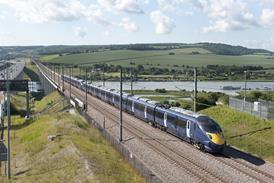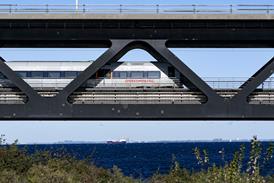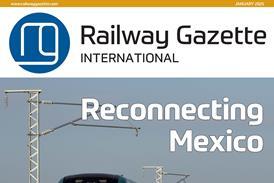INTRO: Union Pacific is putting into revenue service the first of a fleet of 6000hp SD90MAC locomotives designed and built by General Motors’ Electro-Motive Division. Trials at the AAR test centre in Pueblo showed that a single loco fitted with EMD’s novel four-stroke H-engine could handle an 11400 tonne train at an average speed 65 km/h
BYLINE: John N Cavanaugh
Manager, Locomotive Market Development,
Electro-Motive Division of General Motors
DURING March Union Pacific was due to dispatch its first revenue-earning train to be hauled by a production version of the SD90MAC locomotive. The latest and most powerful single-engined diesel locomotive design to emerge from the shops of General Motors’ Electro-Motive Division, the SD90MAC has notched up impressive results during trials at TTC Inc’s FAST track in Pueblo, Colorado, and looks set to become a mainstay of North America’s future locomotive fleet.
Since diesel locomotives developing 4000 to 5000 traction horsepower with AC drives were introduced into revenue freight service in 1993, they have more than proved their worth. Because they increased adhesion and tractive effort by more than 30%, EMD realised that a significant increase in usable horsepower was possible. In 1994 EMD announced the development of a new engine, designed specifically for locomotives, with 6000 traction horsepower available to allow replacement of the SD40-2, for years the backbone of the North American fleet, on a true one-for-two basis.
The new engine is a dramatic departure from EMD history. All previous engines were based on the original 567 series design. EMD developed the 645 engine from the same concept, and the 710 is an iteration of the 645.
The history
The first SD40-2s are over 25 years old. Given that EMD built more than 4700 of these 3000hp models, it is easy to understand why 6000hp was the next logical step in horsepower increase. With a true 1:2 replacement ratio, the economics of reduced fleet size, parts inventory, fuel usage and maintenance create an overwhelming business case for the new product.
Developing engines able to output 6000hp meant increasing displacement, while keeping the overall engine size and weight practical for locomotive application. After considering increasing the horsepower of the current 710 engine, EMD opted for a completely new design, recognising the future demands for reduced emissions and horsepower growth.
EMD began investigating the advantages of four-stroke engines in 1984, eventually building two prototype 16-cylinder ’854H’ engines rated at 4500hp. After recognising the need for a 6000hp engine, EMD searched world-wide for existing designs. Nothing suitable could be found to meet the tough locomotive performance and reliability standards required. EMD then decided to develop the engine itself - a process that was accomplished in only 18 months from design concept to first prototype.
Development
The GM16V265H (H-Engine) is a 16-cylinder, twin-turbocharger design developed in-house by an integrated engineering and manufacturing team to ensure that it met the world class requirements set for it. The H-Engine is a four-cycle design, a real departure from the two-cycle engines that have been one of EMD’s strengths in the world-wide locomotive market.
EMD had a long list of design goals covering reliability, emissions, fuel efficiency, and a 50% increase in horsepower from the current designs. The number one goal uppermost in EMD’s thinking was reliability.
EMD made extensive use of finite element analysis of all structural elements. Other analytical tools included computational fluid dynamics, combustion and air flow studies, vibration and valve train simulations, and design for manufacture and assembly. Once designs were in place, EMD began component fatigue and bench testing.
Initially, two prototype engines proved the designs capable of meeting the stringent locomotive requirements. EMD did its own design work on the twin turbochargers to make it an exact match to this engine/locomotive application. This unprecedented effort was the result of an integrated team of design, engineering, and manufacturing professionals.
EMD was also committed to three-dimensional modelling of the H-Engine and SD90MAC locomotive, resulting in an almost problem-free assembly of the first prototype. Since then, eight engines have been installed in locomotives that are undergoing a rigorous series of performance and reliability tests at the Transportation Technology Centre of the Association of American Railroads in Pueblo, Colorado. Some of these locomotives were due to enter revenue service for Union Pacific in March.
Design features
The H-Engine incorporates several features aimed at improving fuel efficiency, emissions, reliability, durability and safety. The model designation of GM16V265H reflects the fact that General Motors’ products are designed for world markets, and all engine measurements are now metric: ’265’ is the cylinder bore in millimetres. The stroke is 300mm. The H-Engine is rated at 4700 kW at 1000rev/min, operating at a bmep of 21·3 bar.
Another significant departure from the 710 engine is a crankcase that is now ductile cast iron rather than welded steel. The casting incorporates the water manifolds and turbocharger mounting brackets. The cast crankcase provides improved stiffness and high strength to weight ratio. The benefits are reduced vibration and increased durability. The crankshaft is a single-piece forging with large main and connecting rod bearing capacity to accept the load and vibration associated with this size engine.
One centrally-mounted camshaft is now standard on the 265H. The camshaft is assembled in four sections. It is rigidly supported between banks and incorporates an innovative roller follower design. The benefits of this are few bolted joints, lower weight and ease of maintenance.
Carried over from previous EMD engine designs is the unitised power assembly concept. The head, cylinder liner, piston and connecting rod are assembled as one piece that is removable for service as a unit. Because the head-to-liner bolts are separate from the power assembly retention system, a power assembly can be removed without disturbing the head to liner seal. The patent-pending piston is a new design incorporating a Thermoflex crown that provides improved combustion, lower emissions and better fuel efficiency.
Previous EMD designs used a fork and blade configuration. The 265H connecting rods on opposing sides of the vee are positioned side-by-side. This allows for more bearing surface area to support the elevated operating forces. EMD uses a cross-flow design in the cylinder heads of the 265H. The cross-flow design has two air ports - one on each side of the head. Air flows out of the aftercooler into the intake (outboard) port, through the head, and out the exhaust (inboard) port into the exhaust manifold. This cross-flow breathing provides superior combustion that in turn improves fuel efficiency and reduces emissions.
Two turbochargers
A further innovation is the use of two smaller turbochargers instead of a single large turbocharger. The H-Engine’s turbochargers were designed, built, and matched to the engine requirements by EMD. By using one turbocharger per cylinder bank, EMD’s patented aerodynamically variable geometry diffuser achieves a much improved response to throttle changes, emulating the response of a two-cycle diesel. The smaller turbochargers are obviously easier to handle and are interchangeable from side to side.
Previous EMD turbocharger designs were gear driven in lower throttle settings. At higher throttle settings, exhaust pressure alone is sufficient to drive the turbocharger. The 265H turbochargers utilise this low inertia design in all throttle positions. This makes for a much simpler design that provides for longer life, higher reliability, and provides comparable acceleration to the 710, two-cycle engine.
The power to drive the turbochargers is derived from the exhaust gases entering the turbochargers from the exhaust manifolds. On the 265H, there are two exhaust manifolds mounted in the vee of the engine. The supply of fresh air is accomplished by two large capacity aftercoolers that run the length of the engine on each side. This arrangement enables the cross-flow of the cylinder head that improves fuel economy.
An important feature for improved fuel efficiency and emission control is electronic fuel injection, first introduced on the SD70MAC locomotives. Electronic controllers and sensors replace the mechanical linkages and governor of previous fuel systems. The 265H uses a pump - short line - nozzle fuel injection system. Each cylinder has one pump, mounted within the cylinder head and driven by push rod from the central camshaft. The cylinder head mounted pump is connected to the nozzle by a short high-pressure line under the valve cover.
Another new feature of the H-Engine is an antifreeze (propylene glycol) cooling system that permits the unit to be shut down without draining the coolant, saving fuel when units are idling for extended periods.
Locomotive application
The H-Engine was designed specifically for use in the SD90MAC. This is a six-axle, heavy haul freight loco with AC drive. During the trials at Pueblo, the first SD90MACs produced very impressive results.
For example, Unit 8506 succeeded in generating more than 900 kN starting tractive effort, hauling 11400 trailing tonnes at an average speed of 65 km/h on the 4 km FAST track which is used for 6 to 8h a day to test track and rail joints. The FAST test train normally requires four 40-Series locomotives to sustain the average 65 km/h speed.
The ultimate performance, reliability and durability of the SD90MAC will be proven over the next few years.
In designing the GM16V265H, EMD had a very simple approach in mind - clearly and concisely develop the customer’s requirements, establish design parameters to meet those requirements, build upon historical expertise in the design of diesel engines, use recognised railroad and engine design authorities to verify the criteria and resultant designs. Further to this process, EMD established a cross-functional design team to carry out this mission. While the ultimate success of this approach is yet to be measured, the test results are extremely encouraging.
EMD believes the SD90MAC with the 6000 hp H-engine will replace the fleet of over 4700 SD40-2s, and will become the new backbone of the North American locomotive fleet. o
General Motors EMD
Reader Enquiry Number 124
CAPTION: Launch customer for the SD90MAC is Union Pacific
CAPTION: EMD’s H-Engine was designed in-house as a four-stroke machine, breaking with decades of tradition building two-stroke engines
CAPTION: Trials with SD90MAC units at Pueblo demonstrated that they could generate 900 kN of starting tractive effort
CAPTION: Eight SD90MAC units were sent to the AAR’s test centre in Pueblo, Colorado, for testing. Four of them are here seen on UP tracks
Les premières locomotives de 6000 cv d’EMD entrent en service commercial
Union Pacific fait entrer en service commercial la première d’un parc de locomotives SD90MAC de 6000 cv, conçues et construites par la division Electro-Motive de General Motors. Les essais au centre d’essais AAR à Pueblo ont démontré qu’une seule locomotive équipée d’un nouveau moteur H à quatre temps de EMD pouvait tirer plus de 11.000 tonnes à une vitesse moyenne de 65 km/h. Destiné à remplacer le parc nord-américain de SD40-2 sur la base d’une unité pour deux, le parc de SD90MAC offrira aussi des économies en carburant et répondra aux strictes normes les plus récentes en matière d’émissions
Die ersten 6000-PS-Loks von EMD nehmen kommerziellen Betrieb auf
Union Pacific nimmt den kommerziellen Betrieb für die ersten eines Lokomotivenparks von SD90MAC-Loks mit 6000 PS auf, die von der Electro-Motive Division von General Motors entworfen und konstruiert wurden. Probeläufe im AAR-Testzentrum in Pueblo haben ergeben, daß eine einzelne, mit dem neuartigen Viertakt-H-Motor von EMD ausgestattete Lokomotive mehr als 11000 Tonnen in einer Durchschnittsgeschwindigkeit von 65 km/h bef




















